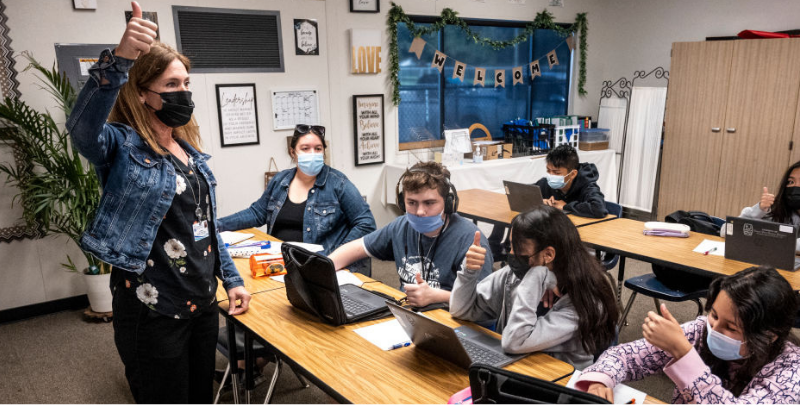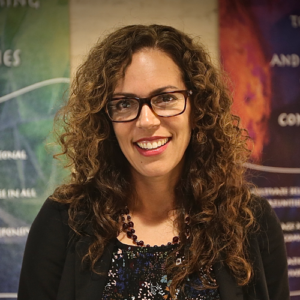Roda, Jackson & Potter: Time to End the Zero-Sum Mindset and Adopt Inclusive, Gifted-for-All Programs in Public Schools

Get stories like this delivered straight to your inbox. Sign up for The 74 Newsletter
In February, the U.S. Department of Education invited public school districts to apply for the Javits Gifted and Talented Program, which awards grants for five-year projects that support “all students, including gifted and talented students, with accelerated learning opportunities.” Specifically, the call for proposals says: “A major emphasis of the Javits program is to identify and serve students underrepresented in gifted and talented programs, to include the training of personnel in the identification and education of gifted and talented students and in the use, where appropriate, of gifted and talented services, materials, and methods, for all students.”
The magnitude of this announcement is that it represents a shift away from models of gifted and talented programming that rely on labeling, sorting and segregating students, and toward designs that encourage inclusion and integration of all children in mixed-ability classrooms. It also represents a philosophical shift in the understanding of gifted education because of its recognition of all children’s innate potential for demonstrating strengths and high intellectual performance.
The Javits program reflects our position on the future of G&T education because it addresses equity through the excellence targeted in gifted education. Some school leaders and policymakers are already re-envisioning what gifted programs should look like, rather than tweaking admissions systems and maintaining separate classes that serve only a select few. For example, students in Baltimore; St. Louis Park, Minnesota; Fairfax County, Virginia; Rockville Centre, New York; and at several schools in Brooklyn, New York, are being exposed to accelerated learning and enrichment opportunities based on the philosophy that all children have unique gifts and talents — and it is the school’s job to identify and cultivate them.
One district that is working toward the goals of the Javits program is New York City. Last fall, then-Mayor Bill de Blasio announced he would eliminate separate G&T programs and replace them with “Brilliant NYC,” an accelerated G&T initiative for all. The plan was to stop testing 4-year-olds for coveted G&T slots, a practice that ended up with more than 70% of the 2,500 seats “assigned to white and Asian students, who make up less than a third of the city’s overall student population,” each year. The new plan was to offer all kindergartners access to accelerated learning starting in September 2022. Yet, because de Blasio announced this change three months before Mayor Eric Adams took office, the city still seems to be at a crossroads, even after extensive planning and outreach.
This is unfortunate, as a review of the research in New York City and beyond finds that the separate and segregated nature of most G&T programs sustains inequities inside schools without adding clear value. In 2013, researchers at Michigan State University compared how students of comparable academic abilities perform when they are admitted to a public school for gifted children versus when they remain in regular-track schools and classrooms. After a year and a half of G&T classes, there was essentially no difference in test results between students in G&T who had scored right above the admissions cutoff and children in regular classrooms who had scored just below. A 2019 study of 2,000 elementary schools across three states by the National Center for Research on Gifted Education echoed those findings: Third graders in gifted programs made no significant learning gains in comparison with their peers in general education.
The problem starts with G&T policies themselves, which lead to inequality and exclusionary behaviors by some parents who can access test prep and other means to secure scarce seats for their children. Students in G&T classes who are segregated from their peers miss out on the numerous benefits of mixed-ability, integrated classes, including higher test scores in math and science and cultural competency skills for global literacy. In addition, sorting students into separate programs or classes unfairly labels them. As Linda Darling-Hammond wrote, “Students’ perceptions of their own ability influence learning. All children are motivated to learn the next set of skills for which they are ready; few are motivated by labels that rank them against others or communicate stigma.”
Discriminatory and subjective admissions criteria such as achievement tests, grades and teacher recommendations that districts typically use to identify students for G&T have been blamed for the segregation — and they are certainly part of the problem. Yet districts must change not only how they identify gifted students, but also how they serve them.
We believe, based on our research and advocacy work with urban and suburban schools, that what is holding some districts back from offering G&T education to all is the assumption that parents with children in separate programs will oppose it. This zero-sum logic, based on winners and losers, is morally, ethically and academically wrong. It perpetuates a system of resource hoarding and racial entitlement. But there is an alternative to such an us-versus-them mentality: the solidarity dividend, also known as a “rising tide lifts all boats” mindset.
There is evidence that New York City families, students and educators will support phasing out separate G&T programs and replacing them with schoolwide enrichment models, such as STEM or International Baccalaureate. It was a parent-led committee at Brooklyn’s Public School 9 that led the school to end G&T. A group of NYC students are plaintiffs in a lawsuit against the city that likens gifted programs to “a racial caste system.” And District 13 Superintendent Kamar Samuels said this about his district’s replacement of separate G&T classes with schoolwide programs: “It’s about all students in the school and all teachers in the school (emphasis added).” Commenting on NYC’s shift to G&T education for all, education scholar Jonathan Plucker, of the National Association of Gifted Children, said, “We should absolutely be doing a lot less separating of these kids, unless there is literally no other way to provide a particular service.”
Many more students lack access to G&T classes than have it. Why not use those numbers as the rationale to provide gifted education to all? What is now a private commodity that benefits mostly white and Asian students can become a public good for all children. It is time to set a new path forward and celebrate all students for their unique abilities and strengths, rather than labeling and sorting them. As the Javits gifted and talented program proposes, more districts should move toward the goal of gifted-for-all programs — and receive funding to do that important work.
Allison Roda is an assistant professor of education at Molloy College in Rockville Centre, New York. Yvette Jackson is an adjunct professor at Teachers College, Columbia University, and senior scholar at the National Urban Alliance for Effective Education. Halley Potter is a senior fellow at The Century Foundation.
Get stories like these delivered straight to your inbox. Sign up for The 74 Newsletter

;)
